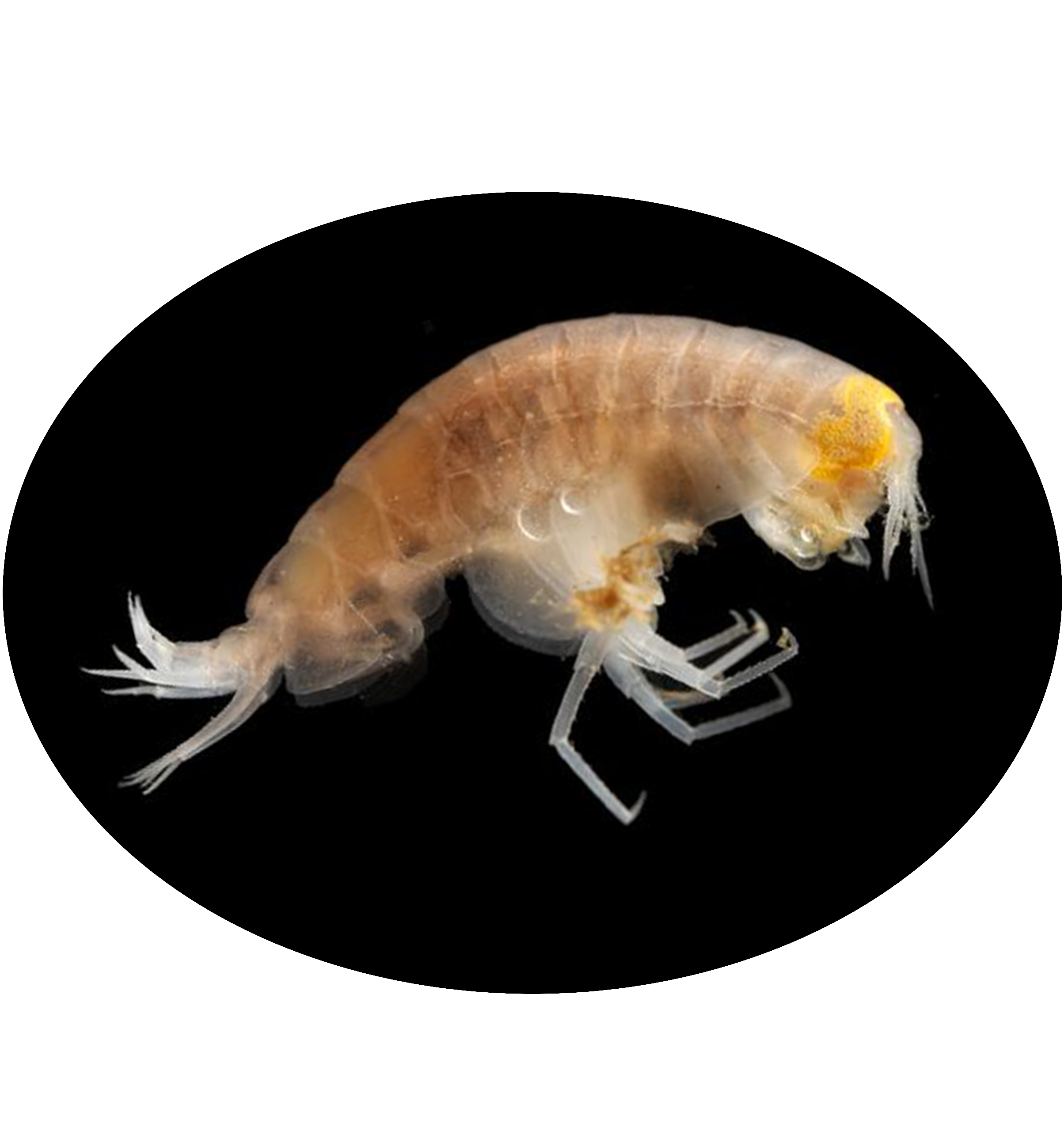
Hirondellea gigas is a species of amphipod crustacean found in the hadal zone of the Pacific Ocean, particularly in the Mariana Trench. It is adapted to extreme deep-sea environments, living at depths exceeding 10,000 meters where pressures are immense and temperatures are near freezing. This species feeds on organic matter that sinks to the ocean floor, playing a crucial role in the deep-sea ecosystem as a scavenger. Its unique adaptations, such as a lightweight exoskeleton and specialized enzymes, allow it to survive and thrive in one of the most extreme habitats on Earth.
Animalia (Kingdom); Arthropoda (Phylum); Crustacea (Subphylum); Multicrustacea (Superclass); Malacostraca (Class); Eumalacostraca (Subclass); Peracarida (Superorder); Amphipoda (Order); Amphilochidea (Suborder); Lysianassida (Infraorder); Lysianassidira (Parvorder); Lysianassoidea (Superfamily); Hirondelleidae (Family); Hirondellea (Genus); Hirondellea gigas (Species)
Tetronychia gigas Birstein & M. Vinogradov, 1955
1. Birstein J A, Vinogradov M E. Pelagicheskie gammaridy (Amphipoda, Gammaridea) Kurilo-Kamchatskoi Vpadiny[J]. Akademiya Nauk SSSR, Trudy Instituta Okeanologii, 1955, 12: 219-257. (Birstein et al., 1955)
Philippine Trench from Philippine Sea, Mariana Trench from North Pacific Ocean and Kuril-Kamchatka Trench
| Species | Phylum | Common Name | Ecosystem | Depth | Habitat | NCBI Taxonomy ID |
|---|---|---|---|---|---|---|
| Hirondellea gigas | Arthropoda | - | Deep sea | 6,800-11,000 | Mariana Trench in the northwestern Pacific Ocean | 1518452 |
| Genome Assembly | Genome Size | Assembly level | Released year | WGS accession | Submitter | BioProject | BUSCO completeness (%) | Scaffold/Contig N50 (kb) | GC content (%) | Repeat Rate (%) | Gene Number |
|---|---|---|---|---|---|---|---|---|---|---|---|
| - | 13.92Gb | Chromosome | 2025 | CNA0142381 | - | CNP0005374 | 89.34 | 458,700/466.1 | 38.8 | 72.75 | 27,881 |
| Title | Journal | Pubmed ID |
|---|---|---|
| The amphipod genome reveals population dynamics and adaptations to hadal environment | Cell | 40054448 |
| Gene ID | Description |
|---|---|
| Hgig_16947 | |
| Hgig_16948 | |
| Hgig_16949 | ORIGIN RECOGNITION COMPLEX SUBUNIT 5 |
| Hgig_16950 | REELIN |
| Hgig_16951 | |
| Hgig_16952 | POTASSIUM CHANNEL, SUBFAMILY K |
| Hgig_16953 | POTASSIUM CHANNEL, SUBFAMILY K |
| Hgig_16954 | DISCOIDIN, CUB, EGF, LAMININ , AND ZINC METALLOPROTEASE DOMAIN CONTAINING |
| Hgig_16955 | |
| Hgig_16956 | SOLUTE CARRIER FAMILY 35 MEMBER B |
| Hgig_16957 | |
| Hgig_16958 | |
| Hgig_16959 | BEAT PROTEIN |
| Hgig_16960 | |
| Hgig_16961 | |
| Hgig_16962 | |
| Hgig_16963 | |
| Hgig_16964 | |
| Hgig_16965 | RIBONUCLEASE H1 |
| Hgig_16966 | DYSTROBREVIN BINDING PROTEIN 1 DYSBINDIN |
| Hgig_16967 | EXCISION REPAIR CROSS-COMPLEMENTING 1 ERCC1 |
| Hgig_16968 | NADH DEHYDROGENASE UBIQUINONE IRON-SULFUR PROTEIN 8, MITOCHONDRIAL |
| Hgig_16969 | |
| Hgig_16970 | SOLUTE CARRIER FAMILY 12, CATION COTRANSPORTERS |
| Hgig_16971 | CASPASE-ACTIVATED DNASE |
| Hgig_16972 | CYPHER, ISOFORM B |
| Hgig_16973 | PROTEIN LIN-28 |
| Hgig_16974 | SODIUM/CHLORIDE DEPENDENT TRANSPORTER |
| Hgig_16975 | SODIUM/CHLORIDE DEPENDENT TRANSPORTER |
| Hgig_16976 | SODIUM/CHLORIDE DEPENDENT TRANSPORTER |
| Hgig_16977 | TRANSPOSABLE ELEMENT-RELATED |
| Hgig_16978 | PROTEIN SIDEKICK |
| Hgig_16979 | |
| Hgig_16980 | ADAM A DISINTEGRIN AND METALLOPROTEASE DOMAIN |
| Hgig_16981 | CYTOCHROME B561-RELATED |
| Hgig_16982 | METALLOPROTEASE TLDD |
| Hgig_16983 | LD35087P |
| Hgig_16984 | UNCHARACTERIZED |
| Hgig_16985 | |
| Hgig_16986 | PROTEIN CBG27172 |
| Hgig_16987 | PROTEIN CBG27172 |
| Hgig_16988 | PROTEIN CBG27172 |
| Hgig_16989 | |
| Hgig_16990 | |
| Hgig_16991 | SELENOPROTEIN S |
| Hgig_16992 | GTP-BINDING PROTEIN-RELATED |
| Hgig_16993 | |
| Hgig_16994 | GTP-BINDING PROTEIN-RELATED |
| Hgig_16995 | MAP/MICROTUBULE AFFINITY-REGULATING KINASE |
| Hgig_16996 | ATF6, ISOFORM C |

